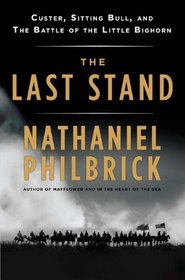Jennifer J. reviewed The Last Stand: Custer, Sitting Bull, And The Battle Of The Little Big Horn on + 4 more book reviews
Helpful Score: 3
An excellent telling of the Battle of the Little Big Horn-clear and easy to read. Well researched and tells all sides of the battle. Definitely worth reading!
Gerald G. (PhotoJer) reviewed The Last Stand: Custer, Sitting Bull, And The Battle Of The Little Big Horn on + 92 more book reviews
Helpful Score: 1
History books are usually boring. This is a rare exception. This reads like a novel. Philbrick's writing is clear and concise. Besides the way he writes there are 2 other aspects to this that make this a very enjoyable read: Philbrick's character development...you feel at the end that you knew all these main characters and second the 18 maps. In historical military fiction, maps are (to my mind) essential elements...this book has a plethora of maps that allow you to see and visualize what happened on another level. This book is a pleasure to read.
R E K. (bigstone) - , reviewed The Last Stand: Custer, Sitting Bull, And The Battle Of The Little Big Horn on + 1458 more book reviews
He was a military man, first and foremost, who followed the orders of his superior officers. Most of the time. Yet sometimes, George Armstrong Custer was a risk-taker. And. most of the time it worked except when it didn't at the last stand. Yes, when it felt right, he would choose his own way to promote his career. So did his wife, Libbie.
This telling of the story we have heard so many times flows wonderfully well with many narratives and comments from those who were there that day. The author's research is outstanding the story telling intriguing. Highly recommended to those who are interested in a clear, concise telling of the battle at the Little Big Horn.
This telling of the story we have heard so many times flows wonderfully well with many narratives and comments from those who were there that day. The author's research is outstanding the story telling intriguing. Highly recommended to those who are interested in a clear, concise telling of the battle at the Little Big Horn.
Leo T. reviewed The Last Stand: Custer, Sitting Bull, And The Battle Of The Little Big Horn on + 1775 more book reviews
Although this is a well-plowed field, the author brings together a great deal of the mountains of evidence, weighs it, and offers (and explains) his conclusion. The book is very detailed but readable for interested folks. The endnotes are lengthy and explanatory, not offering mere citations. Mr. Philbrick spend years on this, including visiting the battlefield severals times, riding over it on horseback, riding the river steamship, and visiting numerous libraries, museums, and archives. He wisely takes much of the story of the battle itself from Indian sources, including pictographs, rightly noting that the participant remembered well every coup. He especially considers the mind set of LTC Custer and Chief Sitting Bull, the leaders of their respective forces. Mr. Philbrick takes help wherever he can find it and generously credits his sources, such as Mr. Vestal who left notes recording his visits with scores of participants from both sides.
Mr. Philbrick, in the wake of many earlier students of the battle, carefully considers the movements of LTC Custer and of his enemies. "Having found a place to cross the river, Custer and the Left Wing rode up to a nearby ridge, where they awaited the arival of Keough and Benteen. They waited for twenty minutes, according to John Stands in Timber, who received his information from Wolf's Tooth, one of the young Cheyenne warriors who had been following Custer's command since it left the Right Wing to the south. By this point, Custer must have been seething with impatience and indignation."
Maps, photos, bibliography, index.
Mr. Philbrick, in the wake of many earlier students of the battle, carefully considers the movements of LTC Custer and of his enemies. "Having found a place to cross the river, Custer and the Left Wing rode up to a nearby ridge, where they awaited the arival of Keough and Benteen. They waited for twenty minutes, according to John Stands in Timber, who received his information from Wolf's Tooth, one of the young Cheyenne warriors who had been following Custer's command since it left the Right Wing to the south. By this point, Custer must have been seething with impatience and indignation."
Maps, photos, bibliography, index.




